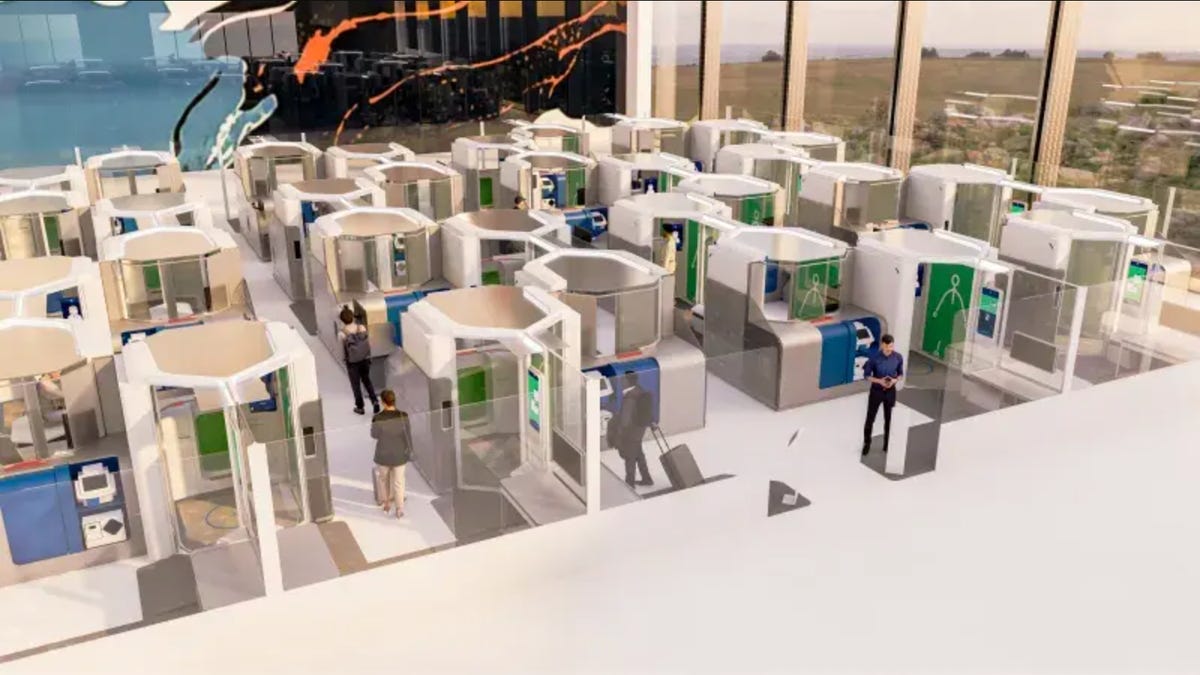Skip Those Long TSA Airport Lines? These New Self-Service Screening Pods Could Help
The TSA is testing a system that would allow PreCheck passengers to complete the security screening process with little to no assistance.

A concept for the self-screening TSA process that could make it easier to clear airport security.
Barely making it to your gate at the airport -- or even missing your flight -- due to long lines at security checkpoints could soon become a thing of the past. Here's why: The Transportation Security Administration is testing a new self-service system that could let you complete the screening process on your own.
The Screening at Speed team and the TSA, which are partnering with the Department of Homeland Security, are giving the public a virtual reality walkthrough of the self-screening system at CES 2024 in Las Vegas this week.
The idea is to reduce the number of pat-downs and bag inspections performed by transportation security officers to free them up for busier parts of screening operations. It also lets you move through checkpoints at your own pace without feeling rushed.
"Like self-ordering kiosks at fast-food and sit-down restaurants, self-service screening allows passengers in the Trusted Traveler Program to complete the security screening process on their own," said John Fortune, Screening at Speed program manager.
Here's how it works.
What exactly is a self-service screening checkpoint?
The self-service screening pods are for TSA PreCheck passengers to use as individual screening consoles. They come equipped with a carry-on screening system to check bags for any prohibited items -- for instance, weapons or liquids exceeding the maximum ounce capacity. It also has a panel that screens the passenger. If you need assistance, there's a button to press to ask a transportation security officer for help.
The self-service checkpoint serves as an alternative to going through TSA checkpoints, which typically requires a full body scan with your arms up while your carry-on items go through a separate screening checkpoint. And if there's an issue found, TSA will either have to search you or your bags. That's not the case with the self-service screening checkpoints.
How does the self-screening process work?
When a passenger steps inside the screening pod, they'll show their ID and then the machine will begin scanning them and their bags. Each station includes a video monitor with step-by-step instructions.
There are automated entry and exit doors. So if someone doesn't pass the screening on the first go -- maybe they forgot to pull keys out of their pocket -- the entry door will reopen so they can remove the items and get re-screened.
The exit door will not open until the passenger passes inspection. Once the screening process has been completed and the passenger is cleared, the automatic exit door will open and the traveler can grab their belongings and head to their flight gate.
Voxel Radar, in partnership with the Screening at Speed team, is working on developing in-motion panel sensors so passengers are screened in near real time while removing belongings.
Which airports will have self-service checkpoints?
For now, the self-screening is a pilot program at the Harry Reid International Airport in Las Vegas. The airport will use Vanderlande's prototype, the PAX MX2, which has an automated screening lane for carry-on bags. There are four integrated stations for one checkpoint lane. Vanderlande is one of the three companies working with the TSA and the Screening at Speed program.
The prototype that's being shown at CES this week is the Micro-X self-screening system. This self-service screening pod is scheduled to be tested in 2025.
For more CES products, check out this ChatGPT-enabled electric car and the most captivating tech at CES so far, including foldable TVs.

